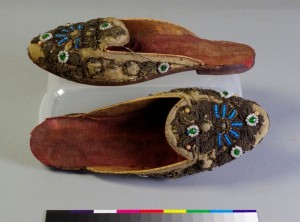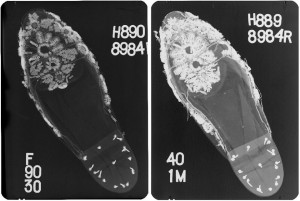Taking A Look Inside A Pair of Slippers with Anna O’Neill
15 January 2014One of the most exciting things about being a conservator is discovering information hidden within an object. Sometimes, this can be quite literally inside an artefact, and for this there is no better tool than an x-radiograph. Conservators can use x-radiography to determine if there is armature within a sculpture, or metal within a lump of corrosion, among other things. Recently, I used x-radiography to examine the construction of a pair of ornamental slippers from Cyfarthfa Castle.

X-rays are the beams of energy that are emitted by the machine. As they pass through the object, x-rays are absorbed by the material and lose energy. Higher density materials absorb more energy, so that fewer x-rays reach the film—these show up as white areas. Lower-density materials allow the beams to pass through with little energy lost and appear darker on the film. The resulting image on the film is an x-radiograph, while the practice of creating images this way is called x-radiography.
There are two factors that affect the final image: the energy (measured in kilovolts, kV) of the x-ray beam, and the time (in seconds) of the exposure. Lower kV but higher exposure time can give greater detail if you’re patient. Higher kV will remove detail from lower density elements but gives a clearer image of higher density materials.
The slippers are probably from late 19th-century India, and are highly decorated with metal and glass beads. My purpose for x-raying them was two-fold: I wanted to see if there were any construction issues that I would need to address, and I wanted to get a better picture of the decorative pattern, which had been obscured by tarnish and time.
In order to see the structure of the slippers, I needed to adjust the settings of the x-ray machine to be sensitive to low-density materials. Using low energy and a longer exposure time produced an image of the organic elements, showing hidden details of the shoe’s construction. The body of the shoe is clear, as the lower-energy beams were better absorbed by the organic materials. The long strips of leather running down the sole provide flexibility and support, while the heel is made of more strips nailed on crosswise. Interestingly, more nails show up on the x-radiograph than are visible on the bottom of the shoe—the extra nails are probably hidden under the velvet insole. I was also pleased to see that the stitching along the edges of the sole was visible in the image.

While the combination of low energy and long exposure time was effective in revealing the organic construction details, the metal decorations were underexposed and unclear. To better see these, I used higher energy and shorter exposure time and placed a thin lead filter over the film. The filter absorbed extra x-rays, producing a clean, sharp image.
With these settings, the pattern of the decoration became much clearer: because the filler material is made of thin metal foil it fades into the background of the image, and the floral design pops. The glass beads are visible, although they lack the clarity of the metallic elements. The increased brightness around the edges of the shoe is due to the fact that the metal elements are perpendicular to the x-ray beam, essentially creating a denser area that absorbs more of the energy.
Between the two x-radiographs, I was able to get a much clearer picture of the construction and decoration of the slippers. With this knowledge, I will be able to design a conservation treatment that is safe for the shoes and highlights their ornamental nature.
-o-
Comments
1 comment
Comments are closed.
- March 2024 (1)
- December 2023 (1)
- November 2023 (2)
- March 2023 (2)
- January 2023 (6)
- November 2022 (1)
- October 2022 (1)
- June 2022 (6)
- January 2022 (8)
- March 2021 (2)
- January 2021 (3)
- June 2020 (1)
- May 2020 (1)
- April 2020 (1)
- March 2020 (4)
- February 2020 (3)
- January 2020 (5)
- November 2019 (1)
- October 2019 (1)
- June 2019 (1)
- April 2019 (2)
- March 2019 (1)
- January 2019 (1)
- August 2018 (2)
- July 2018 (5)
- June 2018 (2)
- May 2018 (3)
- March 2018 (1)
- February 2018 (3)
- January 2018 (1)
- December 2017 (1)
- October 2017 (4)
- September 2017 (1)
- August 2017 (2)
- July 2017 (1)
- June 2017 (3)
- May 2017 (1)
- March 2017 (2)
- February 2017 (1)
- January 2017 (5)
- December 2016 (2)
- November 2016 (2)
- June 2016 (1)
- March 2016 (1)
- December 2015 (1)
- July 2014 (1)
- February 2014 (1)
- January 2014 (4)
Terrific work! This is the type of information that are meant to be shared around the
web. Disgrace on the search engines for not positioning this post
higher! Come on over and talk over with my site . Thank you =)